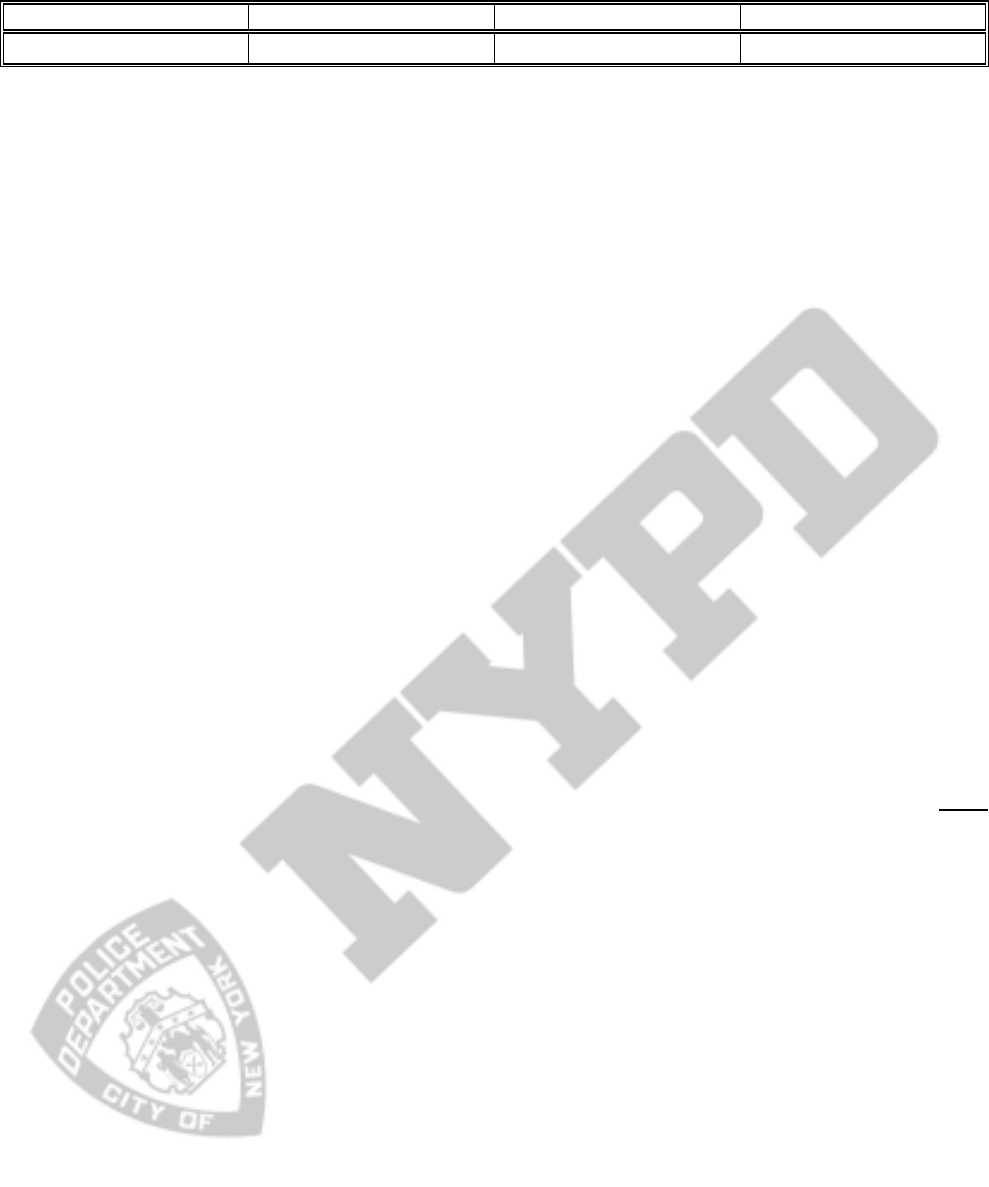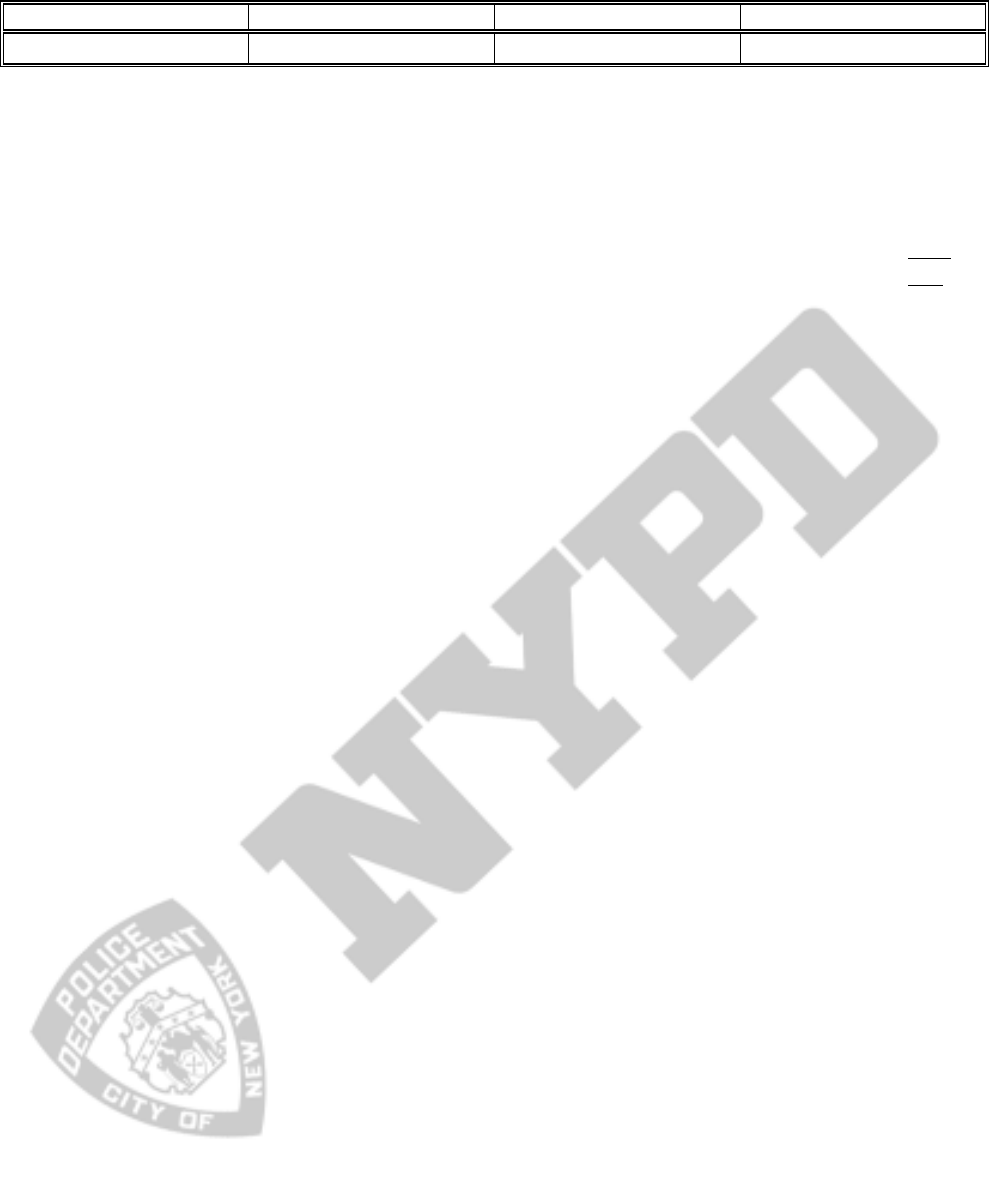
NEW YORK CITY POLICE DEPARTMENT
PURPOSE
To provide for the issuance of a Transit Adjudication Bureau Notice of Violation
(TAB/NOV) in lieu of arrest for eligible individuals apprehended for violating
New York City Transit Rules of Conduct (21 NYCRR, Chapter XXI, Part 1050)
in the New York City Transit System.
SCOPE
Pursuant to section 1204(5-a) of the Public Authorities Law, any person
committing one or more violations of the New York City Transit Rules of
Conduct, shall be subject to either arrest and criminal prosecution in the Criminal
Court of the City of New York or civil penalties imposed by the Transit
Adjudication Bureau. Therefore, after careful consideration of the violator’s
criminal history and potential threat to public safety, members may take
appropriate corrective action by issuance of a Transit Adjudication Bureau Notice
of Violation (TAB/NOV) or Criminal Court summons in lieu of arrest, if qualified.
DEFINITIONS
TAB RECIDIVIST - A subject who has received three or more TAB/NOV
within the last two years or has three or more unpaid/unanswered TAB/NOV
within the last eight years. TAB Recidivists are not eligible to receive a
TAB/NOV for violations of the NYC Transit Rules of Conduct.
TRANSIT OFFENDER - A subject who is on parole or probation or has three or
more unsealed Theft of Services arrests in the last three years or has one or more
unsealed arrest in the transit system for the following crimes:
a. Within the last ten years:
(1) Murder
(2) Any sex offense
(3) Robbery
(4) Felony Assault
(5) Grand Larceny.
b. Within the last three years:
(1) Felony weapon
(2) Assault/Menacing/Harassment
(3) Reckless Endangerment
(4) Larceny/possession of stolen property
(5) Criminal Mischief
(6) Forgery/fraud/unlawful credit card use
(7) Jostling.
PROCEDURE
When a person is observed violating a provision of the New York City Transit
Rules of Conduct within the New York City Transit System:
UNIFORMED
MEMBER OF
THE SERVICE
1. Take violator into custody and inform violator of offense committed,
unless physical resistance, flight or other factors render such notification
impractical.
PATROL GUIDE
Section: Summonses Procedure No: 209-39
PERSONAL SERVICE OF TRANSIT ADJUDICATION BUREAU
NOTICE OF VIOLATION (TAB/NOV) IN LIEU OF ARREST FOR A
QUALIFIED INDIVIDUAL
DATE ISSUED: DATE EFFECTIVE: REVISION NUMBER: PAGE:
03/18/19 03/18/19 1 of 4

PATROL GUIDE
PROCEDURE NUMBER: DATE EFFECTIVE: REVISION NUMBER: PAGE:
209-39 03/18/19 2 of 4
NEW YORK CITY POLICE DEPARTMENT
UNIFORMED
MEMBER OF
THE SERVICE
(continued)
2. Request violator to show proof of identity and residence.
3. Establish violator’s identity and residence through observation of valid
identification documents.
4. Request background check of violator through the local Transit District,
and/or through the use of a mobile device, using the Domain Awareness
System (DAS).
5. Issue violator TAB/NOV in lieu of arrest for observed violation(s), if
qualified, and eject from the system, if appropriate.
a. Disqualifying factors for a TAB/NOV are:
(1) Violator has an active warrant
(2) Violator is wanted in connection with an active
INVESTIGATION CARD (PD373-163) labeled
“Perpetrator – probable cause to arrest”
(3) Violator is charged with other fingerprintable offense(s)
(4) Violator is not properly identified or valid residence
cannot be ascertained
(5) A legitimate law enforcement purpose in addition to the
initial violation can be articulated
(6) Violator is identified as a TAB Recidivist or Transit
Offender.
6. Issue violator a Criminal Court summons in lieu of arrest for the observed
violation(s), if qualified and:
a. Identified as a TAB Recidivist
(1) Use Transit Rule violation code if issuing summons for
fare evasion.
b. Identified as a Transit Offender and the observed violation is other
than fare evasion.
7. Remove violator to Transit District command or a designated arrest
facility and inform desk officer of facts, if violator is disqualified from
receiving a TAB/NOV or Criminal Court summons.
DESK OFFICER
8. Question officer regarding circumstances that led to arrest.
a. Conduct a DAS search to verify background of violator.
b. Determine whether violator should be issued a summons or
processed as an online arrest.
9. Make a Command Log entry including the circumstances of the summons
or arrest.
UNIFORMED
MEMBER OF
THE SERVICE
10. Process the violator as an online arrest if:
a. Violator has an active non-Summons Adjudication Part (SAP)
warrant
b. Violator is charged with other fingerprintable offense(s)
c. Violator has evaded the transit fare and is designated a Transit
Offender
(1) Charge violator with New York State Penal Law offense
of Theft of Services.

PATROL GUIDE
PROCEDURE NUMBER: DATE EFFECTIVE: REVISION NUMBER: PAGE:
209-39 03/18/19 3 of 4
NEW YORK CITY POLICE DEPARTMENT
UNIFORMED
MEMBER OF
THE SERVICE
(continued)
d. A legitimate law enforcement purpose in addition to the initial
violation can be articulated
e. Violator cannot be properly identified or produce valid proof of
residence.
(1) Allow violator to contact a third party in order to obtain
appropriate identification and proof of residence.
(a) Delay arrest processing for a reasonable amount of
time to allow for delivery of such document(s).
(2) Utilize Department computer systems and devices to
ascertain identity of violator, including the viewing of
digital booking photos, querying DAS and by using a
Mobile Identification Device, if available.
(3) Issue a TAB/NOV or Criminal Court summons, as
appropriate, if identity and valid residence are properly
established.
DESK OFFICER
11. Comply with P.G. 208-23, “Computerized Investigation Card System,” if an
active INVESTIGATION CARD labeled, “Perpetrator – Probable Cause to
Arrest” exists, and:
a. Release violator to responding detective, after issuance of summons
returnable to Criminal Court, unless violator is processed as an
online arrest
b. DO NOT release a violator with an active INVESTIGATION
CARD labeled, “Perpetrator – Probable Cause to Arrest,” if no
detective is available to re-arrest the violator
(1) In this situation, process the Transit Rule violation as an
online arrest and inform the assigned Assistant District
Attorney of the circumstances.
VIOLATOR IS THE SUBJECT OF A SAP WARRANT:
DESK OFFICER
12. Direct the issuance of a Criminal Court summons.
a. Utilize the bar code reader to scan the served Criminal Court
summons into the Electronic Summons Tracking System (ESTS).
b. Scan the “Original” copy of the Criminal Court summons into the
network scanner.
c. Create a new summons envelope transmittal for the “Original”
copy of the Criminal Court summons in ESTS and scan the
Criminal Court summons directly to court.
UNIFORMED
MEMBER OF
THE SERVICE
13. Return the arrestee to the Criminal Court Arraignment Part, in the
borough the current violation was observed, to appear on the warrant and
the Criminal Court summons issued for the current violation.
a. The summons issuing officer does not have to be the escorting officer.
b. The arrestee does not have to be returned to the issuing borough
court to vacate the SAP warrant. They can be returned to any
Criminal Court in the City.

PATROL GUIDE
PROCEDURE NUMBER: DATE EFFECTIVE: REVISION NUMBER: PAGE:
209-39 03/18/19 4 of 4
NEW YORK CITY POLICE DEPARTMENT
UNIFORMED
MEMBER OF
THE SERVICE
(continued)
14. Provide the “Original” copy of the Criminal Court summons prepared for
the current violation, as well as a copy of the warrant(s), to the Associate
Court Clerk of the Criminal Court Arraignment Part.
15. Wait with the individual while court staff retrieve the appropriate file(s)
and/or add the matter(s) to the court’s calendar.
16. When called, bring the defendant before the court to adjudicate both the
Criminal Court summons issued for the current violation and the
outstanding warrant(s).
17. Be guided by the judge, court staff, and members of the service assigned
to the borough Court Section regarding the release or continued custody
of the defendant.
DESK OFFICER
18. Direct the issuing officer to release the person from the command and, if
appropriate, eject them from the system, if there are no other reasons to
detain the violator.
ADDITIONAL
DATA
In all cases, when a Criminal Court summons is issued for an observed violation of New
York City Transit Rules of Conduct, the Transit Rules violation code will be used for the
charge.
A Transit Offender will not be issued a DESK APPEARANCE TICKET when arrested
for a crime committed within the New York City Transit System.
RELATED
PROCEDURES
Computerized Investigation Card System (P.G. 208-23)
FORMS AND
REPORTS
DESK APPEARANCE TICKET
INVESTIGATION CARD (PD373-163)
